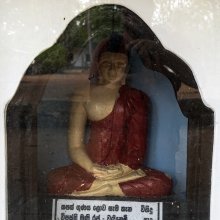Vipashyi, Vipaśyī: 2 definitions
Introduction:
Vipashyi means something in Buddhism, Pali. If you want to know the exact meaning, history, etymology or English translation of this term then check out the descriptions on this page. Add your comment or reference to a book if you want to contribute to this summary article.
The Sanskrit term Vipaśyī can be transliterated into English as Vipasyi or Vipashyi, using the IAST transliteration scheme (?).
Images (photo gallery)
In Buddhism
Tibetan Buddhism (Vajrayana or tantric Buddhism)
Source: archive.org: The Indian Buddhist IconographyVipaśyī (विपश्यी) (or Vipaśyin) refers to one of the seven mortal Buddhas (mānuṣī) whose names appear last in the list of thirty-two Buddhas in Mahāyāna Buddhism.—The last seven Tathāgatas are well-known, and are designated by the Mahāyānist as Mānuṣī or “Mortal Buddhas”. When represented, the last seven Mortal Buddhas appear all alike; they are of one colour and one form, usually sitting cross-legged,with the right hand disposed in the Bhūmisparśa-mudrā (earth-touching attitute), which is the mudrā peculiar to Akṣobhya. [...] In paintings, the Mortal Buddhas [viz., Vipaśyī] have usually a yellow or golden complexion. [...] Sometimes they are represented as standing, in which case the appear under a distinguishing Bodhi Tree and with a distinguishing mudrā.
Vipaśyī is associated with the (Mortal) Buddhaśakti named Vipasyantī, and together they bring into existence the (Mortal) Bodhisattva named Mahāmati.

Tibetan Buddhism includes schools such as Nyingma, Kadampa, Kagyu and Gelug. Their primary canon of literature is divided in two broad categories: The Kangyur, which consists of Buddha’s words, and the Tengyur, which includes commentaries from various sources. Esotericism and tantra techniques (vajrayāna) are collected indepently.
General definition (in Buddhism)
Source: Wisdom Library: Dharma-samgrahaVipaśyī (विपश्यी) refers to the first of the “seven Buddhas” (saptatathāgata) as defined in the Dharma-saṃgraha (section 6). The Dharma-samgraha (Dharmasangraha) is an extensive glossary of Buddhist technical terms in Sanskrit (e.g., saptatathāgata and Vipaśyī). The work is attributed to Nagarguna who lived around the 2nd century A.D.
See also (Relevant definitions)
Starts with: Vipashyin.
Full-text: Mahamati, Vipasyanti, Seven Buddhas, Saptatathagata, Vipashyin, Manushi.
Relevant text
Search found 2 books and stories containing Vipashyi, Vipaśyī, Vipasyi; (plurals include: Vipashyis, Vipaśyīs, Vipasyis). You can also click to the full overview containing English textual excerpts. Below are direct links for the most relevant articles:
